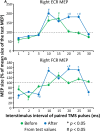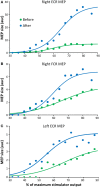Remodeling Brain Activity by Repetitive Cervicothoracic Transspinal Stimulation after Human Spinal Cord Injury
- PMID: 28265259
- PMCID: PMC5316528
- DOI: 10.3389/fneur.2017.00050
Remodeling Brain Activity by Repetitive Cervicothoracic Transspinal Stimulation after Human Spinal Cord Injury
Abstract
Interventions that can produce targeted brain plasticity after human spinal cord injury (SCI) are needed for restoration of impaired movement in these patients. In this study, we tested the effects of repetitive cervicothoracic transspinal stimulation in one person with cervical motor incomplete SCI on cortical and corticospinal excitability, which were assessed via transcranial magnetic stimulation with paired and single pulses, respectively. We found that repetitive cervicothoracic transspinal stimulation potentiated intracortical facilitation in flexor and extensor wrist muscles, recovered intracortical inhibition in the more impaired wrist flexor muscle, increased corticospinal excitability bilaterally, and improved voluntary muscle strength. These effects may have been mediated by improvements in cortical integration of ascending sensory inputs and strengthening of corticospinal connections. Our novel therapeutic intervention opens new avenues for targeted brain neuromodulation protocols in individuals with cervical motor incomplete SCI.
Keywords: cortical plasticity; corticospinal plasticity; primary motor cortex; repetitive transspinal stimulation; spinal cord injury.
Figures




Similar articles
-
Transspinal stimulation increases motoneuron output of multiple segments in human spinal cord injury.PLoS One. 2019 Mar 7;14(3):e0213696. doi: 10.1371/journal.pone.0213696. eCollection 2019. PLoS One. 2019. PMID: 30845251 Free PMC article.
-
Paired associative transspinal and transcortical stimulation produces plasticity in human cortical and spinal neuronal circuits.J Neurophysiol. 2016 Aug 1;116(2):904-16. doi: 10.1152/jn.00259.2016. Epub 2016 Jun 8. J Neurophysiol. 2016. PMID: 27281748 Free PMC article.
-
Repeated cathodal transspinal pulse and direct current stimulation modulate cortical and corticospinal excitability differently in healthy humans.Exp Brain Res. 2019 Jul;237(7):1841-1852. doi: 10.1007/s00221-019-05559-2. Epub 2019 May 11. Exp Brain Res. 2019. PMID: 31079235
-
Stimulation Parameters Used During Repetitive Transcranial Magnetic Stimulation for Motor Recovery and Corticospinal Excitability Modulation in SCI: A Scoping Review.Front Hum Neurosci. 2022 Apr 7;16:800349. doi: 10.3389/fnhum.2022.800349. eCollection 2022. Front Hum Neurosci. 2022. PMID: 35463922 Free PMC article.
-
Induction of central nervous system plasticity by repetitive transcranial magnetic stimulation to promote sensorimotor recovery in incomplete spinal cord injury.Front Integr Neurosci. 2014 May 20;8:42. doi: 10.3389/fnint.2014.00042. eCollection 2014. Front Integr Neurosci. 2014. PMID: 24904326 Free PMC article. Review.
Cited by
-
Timing-dependent synergies between noninvasive motor cortex and spinal cord stimulation in chronic cervical spinal cord injury.medRxiv [Preprint]. 2025 Apr 27:2025.04.17.25326011. doi: 10.1101/2025.04.17.25326011. medRxiv. 2025. PMID: 40313296 Free PMC article. Preprint.
-
Unintentionally intentional: unintended effects of spinal stimulation as a platform for multi-modal neurorehabilitation after spinal cord injury.Bioelectron Med. 2024 May 15;10(1):12. doi: 10.1186/s42234-024-00144-7. Bioelectron Med. 2024. PMID: 38745334 Free PMC article. Review.
-
Optimization of Transspinal Stimulation Applications for Motor Recovery after Spinal Cord Injury: Scoping Review.J Clin Med. 2023 Jan 20;12(3):854. doi: 10.3390/jcm12030854. J Clin Med. 2023. PMID: 36769503 Free PMC article.
-
Spinal electrical stimulation to improve sympathetic autonomic functions needed for movement and exercise after spinal cord injury: a scoping clinical review.J Neurophysiol. 2022 Sep 1;128(3):649-670. doi: 10.1152/jn.00205.2022. Epub 2022 Jul 27. J Neurophysiol. 2022. PMID: 35894427 Free PMC article.
-
Transspinal stimulation increases motoneuron output of multiple segments in human spinal cord injury.PLoS One. 2019 Mar 7;14(3):e0213696. doi: 10.1371/journal.pone.0213696. eCollection 2019. PLoS One. 2019. PMID: 30845251 Free PMC article.
References
-
- Pascual-Leone A, Valls-Sole J, Wassermann EM, Hallett M. Responses to rapid-rate transcranial magnetic stimulation of the human motor cortex. Brain (1994) 117(4):847–58. - PubMed
-
- Chen R, Classen J, Gerloff C, Celnik P, Wassermann EM, Hallett M, et al. Depression of motor cortex excitability by low-frequency transcranial magnetic stimulation. Neurology (1997) 48(5):1398–403. - PubMed
Publication types
LinkOut - more resources
Full Text Sources
Other Literature Sources
Medical

